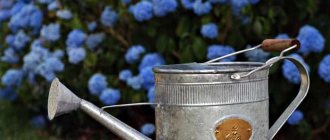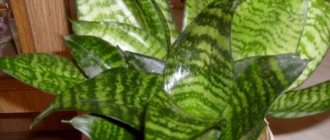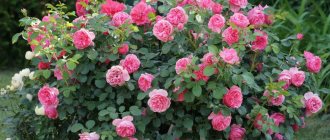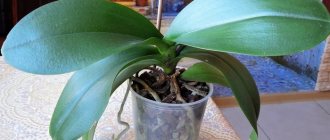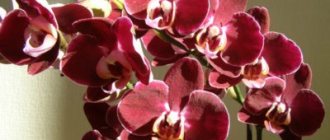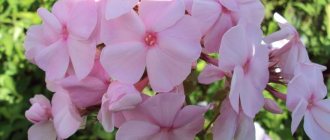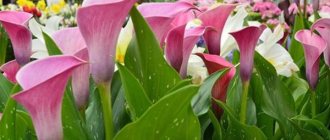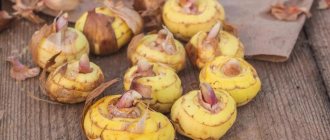By properly caring for hydrangea shrubs in the spring, immediately after the end of winter, gardeners allow the plant to lay a large number of flower buds. In order not to subsequently wonder why an adult lush hydrangea does not bloom in the garden and what it lacks, you need to follow the rules of agricultural technology.
Hydrangea feeding must be carried out evenly in the spring (after winter, a shock dosage of microelements and organic lignins is given) and throughout the summer so that the shrub grows new vegetative mass.
Read about how to properly care for beautiful hydrangeas in your country house and garden in this material, which describes the basics of spring agricultural technology.
Flowering of ngortensia after proper and timely feeding during spring plant care
You can achieve pink and blue flowering by adjusting the amount of microelements and the composition of the fertilizer
Perennial large-leaved and paniculate hydrangea is a luxurious home and garden plant. Mostly miniature species are grown at home. In the garden, large bush plants of the Garden or Tree varieties are more often found. The flower has a peculiarity: its inflorescences react to changes in soil composition. On acidic soils they take on a blue tint; on neutral soils they become white or pink. This must be taken into account when choosing fertilizers for spring and summer feeding, because by maneuvering the compositions, you can significantly diversify the colors of the buds. Fertilizers for hydrangea in spring and summer are simply necessary during the active life cycle for its abundant flowering.
The main reasons why hydrangea does not bloom
Sometimes hydrangeas don't bloom because they don't have enough nutrients. There are a number of reasons. Some of them are worth taking into account, since, for example, if the root system of a flower rots or weakens, the plant does not bloom and cannot be fertilized. Remember that not everything depends on the quantity and quality of fertilizing. Although they often become the reason for the lack of budding. Let's figure it out why this happens.
If in the spring the plant begins to quickly gain green mass, and the flower buds do not turn into buds, then the hydrangea has overwintered in unsuitable conditions. The plant does not tolerate temperature drops to 0° and below. Under such conditions, flower buds freeze and may die. Therefore, in the fall, after the last fertilizing of the season has been applied and the perennial has faded, it is covered with insulating materials. In colder regions, such as the Urals, more drastic measures are required. They try to hide low hydrangeas from the cold at home. Tall ones are grown in greenhouses and greenhouses.
The reason for the lack of flowering of hydrangeas may be improper pruning. This disease occurs more often on newly purchased specimens. Pruning is carried out in the spring, clearing the plant of old and wilted stems. Under no circumstances should you cut off last year's strong shoots. Hydrangea flowers form on them. If you do this, you can see the perennial blooming closer to autumn or the next season.
The root system of hydrangeas is very powerful. Its development affects the budding of the plant. If it is weakened or develops in clay soil, then the plant may not bloom, stocking up on strength to overcome unsuitable conditions. Also, budding can be affected by the external environment. For example, hydrangeas do not bloom in extreme heat and in insufficient soil moisture. You should not be overzealous with watering, since the plant also does not tolerate waterlogged soils.
Feeding should be timely and in optimal quantities. They can also greatly affect the development of hydrangea buds. If you apply nitrogen fertilizers in the spring, this will significantly delay the appearance of flowers on the bush. In summer, such fertilizing enlarges the inflorescences, but this has a bad effect on decorativeness, since the stems lie down under the weight of the flowers.
Pinching, pinching and spring pruning
How to prune hydrangea correctly in spring and whether it should be pruned
In the spring, after removing the cover, it is necessary to carry out sanitary pruning almost immediately. It allows the shrub to return to its former attractiveness, and also prevents the development of diseases and pest attacks.
The first sanitary pruning is carried out in the second year after planting before the formation of new shoots begins. After pruning, the cut areas must be treated with disinfecting compounds.
- Pinching or trimming the ends is necessary to give the bush the correct shape and lush growth. Pinching does not allow the hydrangea to greatly increase in size, the shoots slow down their growth in length, and the lateral shoots grow well. The most suitable time for the procedure is May.
- Stepsonning. The essence of this manipulation is to remove excess lateral processes. It must be carried out in order to obtain lush and voluminous flowering throughout the bush.
- Sanitary pruning is one of the integral components of the agricultural complex. The procedure is seasonal; during it, dry inflorescences and frozen dried shoots are removed.
- Anti-aging pruning is carried out to remove old and weakened shoots. After it, 6-9 strong and strong shoots are left on the bush. Branches older than four years must be removed.
- Thinning pruning is necessary to remove excess branches that grow inside the crown and get tangled. Such bushes create a favorable environment for the development of pathogenic microflora.
Spring pruning of hydrangea (diagram)
Breeders have developed a large number of different varieties; they need to be cared for in different ways.
Pruning large-leaved, serrated and prickly hydrangeas
The first group includes prickly, serrated and large-leaved hydrangeas. Their characteristic feature is that new inflorescences are formed exclusively on last year’s shoots.
Important! Shrubs of these species cannot be severely pruned; only last year's inflorescences should be removed from fertile branches. They should be trimmed carefully without damaging the new buds.
The most suitable time for the procedure is early spring, when the buds just begin to swell or the first leaves appear. First, the bushes are thinned out and frozen and dried branches are removed. Large-scale pruning should not be carried out, since then the hydrangea will bloom only after a year.
Pruning tree and paniculate hydrangeas
The second group includes tree and paniculate hydrangeas. Their inflorescences form on new shoots that formed during the current growing season.
Do not delay pruning, because then the hydrangea will bloom late. After removing the cover, you need to immediately remove last year's shoots. Pruning is necessary to allow the buds to swell. Features of different varieties:
- In paniculate hydrangea, shoots are cut to 1/3 of the total length. The dense crown must be thinned out, removing weak and deformed branches.
- in the tree-like variety, the shoots are shortened so that 2-3 buds remain. On an adult shrub it is enough to leave 1 bud. If you neglect to carry out this procedure, the bush will become thicker, and the inflorescences will form in ever smaller sizes.
Note! At intervals of 5 years, it is necessary to rejuvenate hydrangea bushes by cutting off almost all shoots.
How to fix a problem with a houseplant?
Garden perennials in warm regions differ from indoor perennials in their easier and faster development. Hydrangea becomes picky at home too. Here, not only the temperature of the room air and periodic feeding are important for her, but also the lighting and even the location in the house.
Most often, the cause of wilting and death of a plant in protected soil is the unsuitable composition of the soil. The mixture can change its alkaline and acid levels when watered with tap water. Under no circumstances should this be done, especially if you live in a big city. For indoor plants, choose acidic soils; loam is ideal. In order for the hydrangea to acquire a blue tint, it is watered with melt water with the addition of acetic or citric acid. Some gardeners recommend choosing soil for home hydrangea with a high peat content before solving the problem.
Annual replanting to a new location with renewal of the nutrient soil is an important necessity. As for external conditions, the plant does not tolerate darkening and dry air. Lack of watering is detrimental to it. In order for hydrangea to bloom all summer at home, it is necessary to periodically spray it with melted warm moisture. To avoid getting on the inflorescences, you can wipe the leaves with a damp, lint-free cloth.
The reason why hydrangea does not bloom indoors may be the age of the plant. We recommend updating it at least once every 4-5 years. At this age, the perennial can begin to grow and spends less energy on budding. Therefore, experienced gardeners, using vegetative propagation methods, renew the shrub. The same goes for garden perennials.
Soil acidification
Hydrangeas (with the exception of large-leaved ones) love acidic soils, so the soil in the root zone must be periodically acidified. For example, a solution of citric acid at a concentration of 10 g per 10-liter bucket of water. It is recommended to water them twice a season - in June and August. Lemon strengthens the plant and gives elasticity to the branches, which is important for holding heavy flower caps.
A solution of table vinegar ( 9% ) is also suitable for acidification : 100 ml per 10 liters of water. Water during the active growth phase and before budding.
Mulching with peat or pine needles also serves this purpose.
A layer of mulch retains moisture, does not give weeds a chance, and insulates the roots in winter
Frequency of application of nutritional supplements
To maintain abundant flowering of hydrangeas, you need to apply nutritional fertilizers three times a year. This frequency greatly facilitates the care of perennial indoor and garden plants. The first fertilizers are used in the spring, when the plant begins to grow and green leaves begin to appear. Ready-made fertilizers with a high nitrogen content are used as mineral complexes. This element gives a good effect and supports the development of green tops, especially in garden hydrangeas. Potassium is also of great importance in the spring.
In summer, when active budding occurs, approximately the same amount of nitrogen fertilizers and potassium is required. But when hydrangea blooms, phosphorus becomes its most important element. Also, at this time, you can adjust the shade of the buds by lowering or increasing the acidity using special complexes. On neutral soils, hydrangea turns white. High nitrogen affects this plant very differently than other perennials. The fact is that with a large amount of this element, the plant’s inflorescences become very large. But this has an adverse effect on the appearance of the shrub, since under the weight of the flowers the stems droop and can break.
The summer period of organizing care involves periodically feeding hydrangeas with organic substances. Kemira Tsvetochnaya has proven itself best as ready-made complexes. During the entire summer, fertilizing should be no more than three procedures. Milk, kefir or whey can be used as non-standard fertilizers, since the plant often requires lactic acid.
In autumn, one of the most important fertilizing procedures is carried out. It is necessary for the bush to lay new flower buds and bloom profusely the next season.
Fertilizing in spring in the garden
Garden hydrangea is one of the most popular types of plants from the entire vast genus of Hydrangeaceae. In spring, perennials require special care and attention, as this is the most important period. We can say that at this time of year the hydrangea “decides” whether it will bloom or not. Therefore, pay attention to the fact that right now one of the key feedings of the plant is required.
For 10 liters of clean water, take a tablespoon of potassium sulfate and urea. This solution contains the optimal amount of nitrogen, which is currently necessary for the growth of green mass. Follow the recommended proportions so as not to spoil the bush. Apply no more than 5 liters of solution per rhizome. It is advisable that the water be warm - room temperature. Nutrients are added strictly before the buds appear. It is best as soon as the snow melts in the garden in the spring.
To ensure abundant flowering of hydrangeas in the spring, the plant is fertilized with mineral complexes. It is important that they contain sufficient amounts of potassium and phosphorus. During the period when the plant is preparing for budding, it is necessary to reduce the amount of nitrogen fertilizing. They can adversely affect the development of flowers. Superphosphate is suitable as a mineral composition. Three times in the spring you need to water the bush with a solution of potassium permanganate. This is necessary so that the plant develops more resistant to diseases and its stems are more flexible and resilient.
Planting hydrangea in open ground: location, soil, distance and depth
The plant is heat-loving, fast-growing and needs fertile soil and sufficient moisture.
We describe planting in open ground for any type of hydrangea: oak-leaved, large-leaved (garden), paniculate, serrate, tree-like, petiolate, Sargent and others.
Landing location
Hydrangea (all types) is a light-loving plant; it grows well in a sunny and open place, but bright sun and strong wind should be avoided. Therefore, at the peak of the heat, light shading is necessary; she really loves diffused light.
At the same time, the shrub is able to grow well in light partial shade; in this case, it blooms later with fewer flowers. The presence of sunlight in the morning, in the first half of the day, is very important. Therefore, the eastern side is better suited than the western side.
Soil and acidity
Hydrangea grows well in fertile, humus-rich clay soils. It develops worse on red soils, and sandy soils are contraindicated.
The optimal acidity level is pH 5.2-6.0 (slightly acidic soil). The maximum brightness of inflorescences is observed precisely on acidic soil, and on neutral soil they develop slowly and are pale in color.
Alkaline soil leads to chlorosis (yellowing of leaves). When a bush grows on alkaline soil, there is often a lack of iron and magnesium, which is manifested by light and pale color of the leaves.
Therefore, acidify the soil or treat the bush with iron chelate. In past centuries, gardeners buried objects made of iron (nails, a jar, a horseshoe).
When planting, prepare a special balanced soil mixture with fertilizers.
Soil mixture
Composition: humus, turf soil, leaf soil and peat - equal parts or humus, garden soil (chernozem), peat and sand - 2:2:1:1. And also nutrients: 20-25 g (tablespoon + teaspoon) of carbamide (urea), 24-29 g of potassium sulfate (two tablespoons) and 60-70 g of superphosphate (150-250 g of bone meal).
If spruce and pine trees grow nearby, then you can dig up light, loose and slightly acidic soil under them. Some gardeners successfully grow flowers in such soil, even without applying fertilizers during planting.
Complete ban on lime, chalk and wood ash.
Landing distance
Large-leaved - 120-160 cm, and paniculate - 140-240 cm between bushes, and from the nearest large shrubs and trees - 230-300 cm. If you want to plant hydrangea in a row (hedge, “mixborder”), then you can dig a trench wide 90-110 cm.
If you want to achieve earlier flowering, then when planting, dig holes closer to each other (70-80 cm), and after 2-3 years, thin out the bushes if necessary.
Planting pit
Depth – 36-45, width – 51-65 cm. The roots grow mainly in breadth, extending much further than the crown.
Planting depth
The root collar should be located at soil level, a maximum of 2-3 cm lower, otherwise the flower will develop poorly.
Step-by-step instructions for planting hydrangeas
- Dig a hole of the desired size 15-30 days before planting.
- Prepare the soil mixture and fill the planting hole.
- Dig a hole and place the seedling on a cone of soil mixture at the desired depth and straighten the roots. Gradually fill the hole and compact the soil.
- Water the bush with 8-12 liters of water and sprinkle with bark, sawdust or peat - 6-8 cm thick and 16-20 cm in diameter.
- Cover the flower from direct sunlight during the day and strong wind.
When is the best time to plant hydrangea? Spring or autumn?
The best planting time: spring - early May and autumn - September. At the same time, the most favorable period to plant hydrangea in cold climates is only spring, and in more southern regions it can be planted in spring and autumn.
Caring for hydrangea after planting
Preparing for flowering
For the first two years, cut off the inflorescences at the bud (pea) stage. And then the plant will direct all its forces to the development of the root system and above-ground parts, which will ensure better flowering in subsequent years.
- Watering, fertilizing, pruning and preparing for winter - see the relevant sections.
Summer feeding of hydrangea
Summer is the time when hydrangea blooms very profusely, long and luxuriantly. To support the budding process, you need to organize periodic feeding for the perennial. Some gardeners use organic matter in the summer. But you need to be very careful with it, as it contains a large amount of nitrogen. As an organic complex, you can use diluted bird droppings or slurry. Dilute the component in warm water in a ratio of 1:10. No more than 5 liters of solution are poured under one bush.
Summer feeding occurs no more than once a month. You can use complex mineral compositions. Kemira has proven herself well. It contains a lot of useful nutrients. To increase the acidity of the soil and to make the hydrangea change color, you can use non-standard fertilizers. For example, to make the plant color the inflorescence blue, you can feed the perennial with soaked bread. But first, wait until the mixture infuses and sours.
Secrets of watering
- Hortensia
is watered in the spring with settled, sun-warmed water. The optimal temperature is 30-35°. - In dry, warm weather, water once a week, in cool weather - once every 10-15 days. Apply 10-12 liters for each adult bush.
- Once every 2-3 weeks it is useful to add potassium permanganate crystals (a faint pink solution) to the water. This will protect the hydrangeas from bacterial infections.
- To retain moisture, place a layer of peat and wood shavings mulch 7-10 cm high.
Fertilizers for hydrangeas in the fall: preparing for winter
In autumn, hydrangea is prepared for a long period of winter dormancy. At this time, the perennial begins to lay flower buds for the next year. Therefore, the plant simply needs fertilizers. We recommend choosing formulations with a high content of potassium and phosphorus. You can use superphosphate or potassium sulfate. Phosphorus helps the plant to lay as many flower buds as possible in the fall. Potassium is needed for the root system so that it can survive the cold.
For 10 liters of clean water, preferably warm and melted, take 1 tbsp. a spoonful of potassium sulfate and superphosphate. One bush accounts for no more than 7 liters of the resulting solution. You need to apply nutritious fertilizers only after the hydrangea has bloomed. The perennial does not need nitrogen in the fall. On the contrary, it can cause the death of a flower in the cold season. The fact is that nitrogen makes the perennial grow faster. If you feed hydrangea in the fall with nitrogen complexes, it will begin to rapidly grow shoots, which is completely unacceptable when preparing a perennial for winter dormancy.
In the fall, you can mulch hydrangea with natural organic matter. Manure and peat have proven themselves best. The mulch level should be no more than 5 cm. It helps hydrangea survive a strong drop in soil and air temperatures.
Look at the video further on the page on the basics of applying spring fertilizing to hydrangea bushes after winter and throughout the summer:


